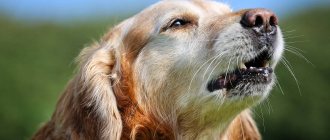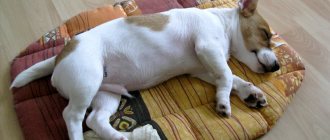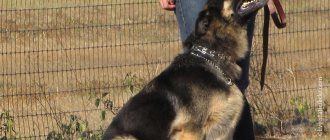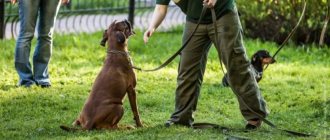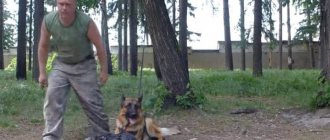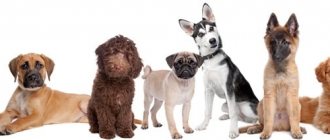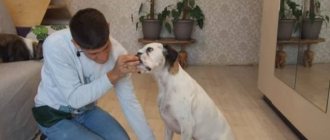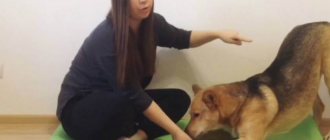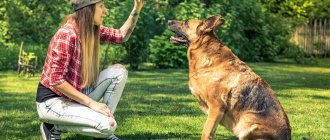On the command “Near” the dog should align itself with you on the left side .
so that her shoulder is level with your leg, and move in this position until you let her go for a walk. The dog must follow the command both on a leash and without it. Despite the fact that this exercise seems simple to you and me, for a pet it is considered one of the most difficult.
You should start teaching your puppy the “Near” command only when he already knows how to walk on a leash and knows not to push or pull. It is best to start training at the age of 6 months, since the “Nearby” command is sometimes based on harsh coercion, which cannot be done with small puppies. So, let's look at how to teach a dog the “Near” command.
Why teach your dog the “here” command?
The “side by side” exercise is studied to pass such standards as OKD (general training course), IPO (three-level testing of service dogs) and obedience (international obedience standard), and is also one of the most useful skills in everyday life. On walks, it often happens that at certain moments (crossing the road, walking past another dog, walking around a person who is afraid of an animal) you need the dog to walk next to you. That is why the “near” command is one of the key exercises in training.
Stage 3. Changing the direction of movement
Teaching a dog to change direction is not at all difficult. To begin, make smooth turns - turn in a semicircle. Over time, gradually begin to turn more and more sharply, eventually achieving a right angle turn. This will require about two weeks of training. Remember that, no matter how smooth the turn you make, before starting the maneuver you must give the command “Near!”
Command execution requirements
The command “near” is executed differently by the dog for different purposes.
Executing a command as an exercise used in everyday life
When the owner pronounces the command “near”, the pet must attach itself to the person’s left leg and walk at the level of his knee, without changing the correct position, regardless of whether the trainer decides to run, turn or stop. In any case, the dog must adapt to the rhythm of the owner’s movement, maintaining its position near his knee.
Execution of a command as a means of passing a sports standard
Movement nearby is carried out without a leash.
The dog must follow the handler, walking to his left. The animal's body must be parallel to the handler. The dog's shoulder should be level with the handler's left knee.
The “nearby” command is given when starting to move, changing speed, as well as when turning and turning on the spot.
When the trainer stops, the dog takes the main position next to him immediately and without a second command.
Important!
Pay attention to some "don'ts" and always try to stick to them. So, the following is not allowed:
- Yank the leash in front of the team.
- A tight leash when walking while teaching a command. The dog must walk on a loose leash.
- Change intonation when giving a task.
- Repeat “Next” if the dog walks nearby and complies with all requirements.
- Punish the dog for incorrect or failure to follow a command.
By following these rules and observing some principles, you can easily teach your dog the “Near” command.
When is the best time to start training?
The “near” command can be learned at any age. Of course, to pass the sports standard, the process will be more complicated, and the puppy cannot be trained at a serious level right away, since you need to start by laying the foundation.
Training the “next” command at a serious level for the purpose of sporting achievements within the framework of IPO or obedience is recommended to be carried out accompanied by an experienced dog handler, since such training has a lot of difficulties and nuances that are difficult to understand solely with the help of the Internet or books on training.
If we are talking about a command for everyday life, the learning process will not be difficult, because for a household command there are no strict performance criteria.
The main thing is to observe timing and choose the duration of training according to the age and experience of the dog. For puppies, the lesson can last several minutes, but for an experienced dog, the lesson time can be increased.
Training conditions
The “Nearby” command is part of the dog’s overall training program. To achieve results, a home trainer will need patience, consistency and compliance with the following conditions:
- regular execution of the order - two to three times a day for 5-10 minutes;
- alternating classes on a new topic with consolidation of previously learned skills to diversify the educational process and increase the student’s motivation;
- the tool necessary for training a large adult pet is a jerk chain, which perfectly corrects the behavior of an overexcited animal (a soft leash is suitable for a 3-4 month old puppy);
- a trouble-free motivator - treats;
- the place of initial study is a secluded room / quiet courtyard or park, where there are no squealing children, running animals and noisy cars.
To begin, dedicate a weekend or three to four days a week to teaching the Nearby command. This training schedule will not take much time and effort, but will soon bring results.
Which delicacy to choose
The choice of treat is a matter solely of the animal’s taste preferences. As a rule, dogs like meat and offal the most. Meat can be given both raw and boiled.
Of course, many pets prefer other products (cheese, cottage cheese, vegetables, canned dog food, etc.) to meat products. It is important to choose the treat that your dog likes the most. To do this, you need to experiment and, through trial and error, find the treat that is right for your pet.
Choosing a place to study
The initial stages of training can be carried out in an apartment or house, since at this stage of training you will not need a lot of space. The advantage of training at home is that the dog is already accustomed to it and will not be distracted by various external factors.
If your pet is well oriented toward you outdoors, you can conduct classes in an open area. It is better that the place is well known to the dog.
Make sure that there are as few irritants around as possible that could distract the animal from the training process.
What does the owner need?
First of all, when you want to teach a dog to follow a command, you need to encourage it. Bring your pet's favorite treats with you on walks to reward him for good work and obedience. If you see that the animal is tired and refuses to walk “Next” as required by the technique, reschedule the lesson until tomorrow.
When giving a command, you need to speak calmly, confidently, without raising your tone or changing your intonation. There must be a trusting, friendly relationship between the owner and the dog.
Tired, want to relax? Book a dog walk!
Find out more
submit your application
Ways to train a puppy and an adult dog
It is important to understand that you cannot learn a command in one go. Learn the exercise step by step, without putting all the learning steps into one approach.
You can divide the number of approaches throughout the day so that your pet does not get bored with the training process.
The leash in the “nearby” command is used solely for the purpose of safety net. Jerking will not benefit either you or the dog, as it will not help explain the task to your pet.
Method 1
Show your dog a treat. As soon as the pet “puts its nose” into your palm with food, move it to the “near” position near your left knee so that the animal’s shoulder blades are at its level. Once you have directed your dog to the desired position, give him the treat. Repeat this several times.
Move the animal to the desired position “next to” near your knee and start moving. First, take a step forward with your dog, pointing him in the direction of movement with a treat. If your pet does not deviate anywhere and steps along with you, give him a treat. Gradually, you can increase the number of steps.
Change the rhythm of your movement. You can speed up or, on the contrary, slow down. Praise your dog for staying close to you.
While moving, try to smoothly turn in any direction, using a treat to guide the dog next to you. If the animal deviates or goes the wrong way, use a treat to move the dog into the right position. Gradually, add more turns in different directions.
As you move, stop with your dog. As soon as she stops with you, praise the animal and command “sit.” If your pet is sitting crookedly, use a treat to correct its position. Repeat this several times. During the entire training process, the dog will remember that after each stop you make, it must sit down.
Gently remove your hand with the treat from your dog's nose. Ensure that the dog walks independently without your prompting.
The main thing is to do everything gradually, without making sudden leaps from stage to stage.
Don't feed your dog as often as you did in the early stages of training. Do not praise your pet for basic movement forward (do this only occasionally in order to surprise the dog with unexpected praise to increase the animal’s motivation), feed the dog for performing more complex elements (stopping or turning).
As soon as your dog walks along on his own, praise him for making eye contact with you.
If the dog walks next to you, looking into your eyes, the quality of the command and your contact with the dog will be much better!
Method 2
Rub your palm with a treat so that it smells like a treat and hand it to your pet. As soon as he touches your palm with his nose, give the animal a treat from the other hand. Repeat this several times, then ask your pet to hold his nose on his palm, starting from 1 second. Once the dog understands the task, enter the voice command “target”.
Stand next to the dog and extend your palm so that the dog, touching it with its nose, is at the level of your left knee. Command "target". Once the animal has complied, give it the treat from the other hand. If the pet does not understand the task, go back one step to the stage of learning the “target” command. Repeat several times.
Stand next to the dog, command “target” and take a step forward. The pet should, resting its nose on your palm, take a step with you. If the dog complies with the requirement, give him the treat and repeat this several times, then increase the number of steps.
Vary your pace. Speed up and slow down with the animal. If your pet successfully maintains the position, give him a treat.
As you move, gently turn with your dog. Make sure your pet continues to keep his nose on your palm. After a successful turn, give your dog a treat from your other hand. Repeat this several times, including more and more turns in different directions in the trajectory of your movement.
Make stops along the way. As soon as the dog stops with you, praise it, then, holding your palm on the animal’s nose, command “sit.” If the pet does not understand the task, try giving the command “sit” without a target, and then again try to get the dog, resting its nose on your palm, in a sitting position. Repeat this several times.
Gradually remove your palm from the dog's nose. At first low, then higher and higher until it is completely removed. First, praise the animal for walking with you without a target, then increase the steps. Once your pet understands the task, incorporate turns and stops.
Ultimately, you can praise your dog for making eye contact with you during the “near” movement. The more often and longer your pet looks into your eyes, the better and more efficiently the command will be carried out.
How to conduct the first lesson?
For the first lesson, it is better to choose a deserted place; it is advisable that the road is straight, without any sharp turns or difficult terrain. Moreover, the owner must walk at an active pace. This is necessary so that the puppy does not have time to get bored and sniff the neighboring bush. If the dog is quite active, then it is first important to give it time to run around and use up excess energy. When the dog is interested in something, then you should give it the opportunity to satisfy its curiosity and sniff the object, but this should be given no more than 15 seconds.
For the first training, it is important not only to stock up on a short leash, treats, but also patience. If the puppy is near the left leg at least temporarily, then he needs to be praised and then given a treat. You can periodically repeat the command “Near” and pat yourself on the thigh.
Basic mistakes
- Reward your dog when he is in front, to the side or behind your knee. Carefully monitor your pet's position in learning and performing the command. Only praise the animal when its shoulder blades are level with your left knee. If you encourage the wrong position, the dog will get used to walking around crookedly and incorrectly.
- Attempts to physically influence the dog in order to correct an unclear position. Guide your dog to the correct position using treats only. Do not try to lean on the animal in any way with your foot or correct its position with your hands in order to correct the inaccuracy of the command. If you physically influence your pet, it will be much more difficult for him to remember the algorithm for executing the command, since your actions will confuse the animal.
- Working with a distracted or tired animal. The results of training will appear only when the pet is fully involved in the work. If the dog is distracted during training, then find out and eliminate this reason. As a rule, an animal may become distracted due to lack of motivation, overwork, a large number of stimuli, or lack of understanding of the task. Choose a time for training so that your pet is in an alert state.
- Rewarding the dog when it deviates from the “near” position. Learn to praise your pet only at the moment the command is executed, and not after. If you praise the dog verbally, after which it deviates from the position in anticipation of reward, return the pet to the correct position, and then give the treat.
Brief conclusions
Work confidently with the dog, do not be distracted by extraneous activities. It is best to conduct training at the same time every day:
- The nuances of your pet's character and preferences are of great importance in achieving results. Sometimes replacing edible rewards with a reward in the form of a toy is more motivating. A four-legged friend does not always react properly to a treat.
- A dog that has been walked and run around is much more trainable. Otherwise, the animal will perceive the entire event as a walk, which will reduce the dog’s concentration on fulfilling the requirements. Start training in deserted places, gradually moving to areas with distractions, passersby, and near highways. Then your dog will respond adequately to the command “Near!” in any situation.
- For command training for adult large dogs, it is allowed to use a strict collar with curved spikes (parfors). This is a temporary control option. As soon as your pet learns to respond adequately to requests, replace it with a regular collar. And only after this can you try to teach him the “Nearby” command without a leash, when you are sure that the dog will not run away or try to harm passers-by.
Increase the complexity of the team only as you master the skills, take your time and act consistently. Take training seriously, regularly devote time to training your dog, encourage it and praise it often - after all, these are not only your achievements, but also your pet’s. And most importantly, be patient and persistent. Then you will succeed.
Briefly about the main thing
- Choose a quiet and familiar place for the dog to train. Eliminate all distractions.
- Take the treat that is most valuable to your pet. Do not try to offer the animal a treat that is not interesting to him.
- If you are not sure that the dog will not run away during training, put your pet on a leash, but do not use it for training by jerking.
- Using a treat, move the animal to the “near” position near your left knee, then praise the pet. Gradually increase the criteria and make the task more difficult: move forward, turn, stop, speed up or slow down. Also, you can learn the “target” command and use it to learn the “near” command. Subsequently, the target is removed and the dog independently carries out the command.
We hope that this article will help you in training your pet. If you have any questions, ask them in the comments. We wish you good luck in training your four-legged dogs!
Does training success depend on the dog's breed?
As a rule, all dogs are trainable, regardless of breed and size; differences can only be in the speed of mastering the command. Some breeds (retrievers, poodles, German shepherds, papillons, shelties, Dobermans and Rottweilers) learn faster, some (chow-chows, bulldogs, Afghan hounds) take longer, but it all depends on the owner, his readiness and efforts in training the pet.
Also, the speed of learning can be affected by the characteristics of the pet - dogs with high activity are less able to keep their attention on the task at hand.


